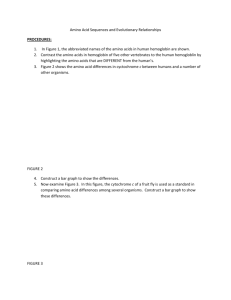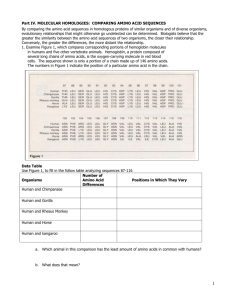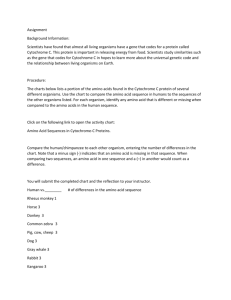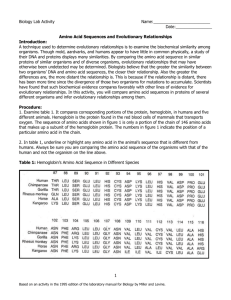Amino Acid Sequences and Evolutionary Relationships
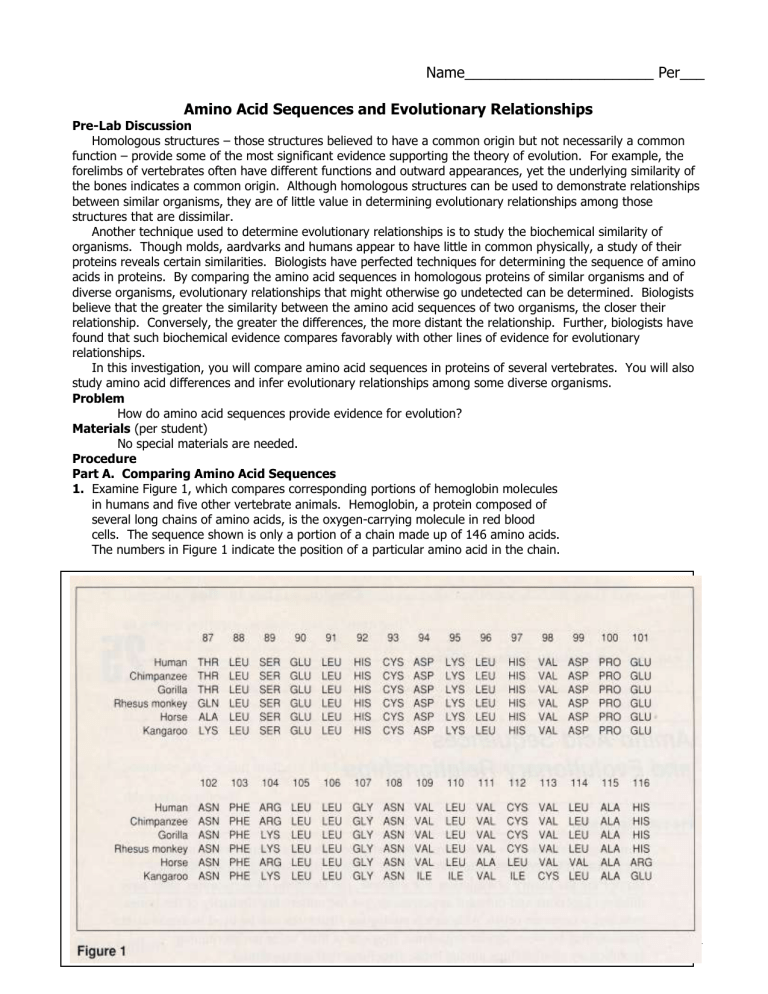
Name_______________________ Per___
Amino Acid Sequences and Evolutionary Relationships
Pre-Lab Discussion
Homologous structures – those structures believed to have a common origin but not necessarily a common function – provide some of the most significant evidence supporting the theory of evolution. For example, the forelimbs of vertebrates often have different functions and outward appearances, yet the underlying similarity of the bones indicates a common origin. Although homologous structures can be used to demonstrate relationships between similar organisms, they are of little value in determining evolutionary relationships among those structures that are dissimilar.
Another technique used to determine evolutionary relationships is to study the biochemical similarity of organisms. Though molds, aardvarks and humans appear to have little in common physically, a study of their proteins reveals certain similarities. Biologists have perfected techniques for determining the sequence of amino acids in proteins. By comparing the amino acid sequences in homologous proteins of similar organisms and of diverse organisms, evolutionary relationships that might otherwise go undetected can be determined. Biologists believe that the greater the similarity between the amino acid sequences of two organisms, the closer their relationship. Conversely, the greater the differences, the more distant the relationship. Further, biologists have found that such biochemical evidence compares favorably with other lines of evidence for evolutionary relationships.
In this investigation, you will compare amino acid sequences in proteins of several vertebrates. You will also study amino acid differences and infer evolutionary relationships among some diverse organisms.
Problem
How do amino acid sequences provide evidence for evolution?
Materials (per student)
No special materials are needed.
Procedure
Part A. Comparing Amino Acid Sequences
1. Examine Figure 1, which compares corresponding portions of hemoglobin molecules
in humans and five other vertebrate animals. Hemoglobin, a protein composed of
several long chains of amino acids, is the oxygen-carrying molecule in red blood
cells. The sequence shown is only a portion of a chain made up of 146 amino acids.
The numbers in Figure 1 indicate the position of a particular amino acid in the chain.
1
2. In Data Table 1 in the Observation section on page 3, notice that the abbreviated names of the amino acids in human hemoglobin are printed.
3. In the appropriate spaces in Data Table 1 on page 3, write the abbreviated name of each
amino acid in chimpanzee hemoglobin that is
hemoglobin. If there are no differences, leave the spaces blank.
4. For the remaining organisms, write the abbreviated names of the amino acids that
do
not different from
correspond to those in human hemoglobin. Note:
that in human
Always be sure that you
compare the amino acid sequence of each organism with that of the human and not
the organism on the line above.
5. Use Data Table 1 (on page 3) to complete Data Table 2 in the Observation section on page 3.
Part B. Inferring Evolutionary Relationships from Differences in Amino Acid Sequences
1. Another commonly studied protein is cytochrome c. This protein, consisting of 104
amino acids, is located in the mitochondria of cells. There it functions as a
respiratory enzyme. Examine Figure 2. Using human cytochrome c as a standard,
the amino acid differences between humans and a number of other organisms are
shown.
Species Pairings # of Differences
Human-chimpanzee 0
Human-fruit fly 29
Human-horse 12
Human-pigeion 12
Human-rattlesnake 14
Human-red bread mold 48
Species Pairings # of Differences
Human-rhesus monkey 1
Human-screwworm fly 27
Human-snapping turtle 15
Human-tuna 21
Human-wheat 43
Figure 2
2. Using Figure 2, construct a bar graph on Graph 1 (on page 4) to show the amino acid differences
between humans and other organisms.
Keep page 1 and 2. Turn in page 3 & 4 to your teacher when you are finished with the lab. Don’t forget to write your name on page 3 before turning it in.
2
Name________________________ Per___
Observations
Data Table 1
Data Table 2
Organisms
Human and Chimpanzee
Human and Gorilla
Human and Rhesus Monkey
Human and Horse
Human and kangaroo
# of Amino Acid Differences Positions in Which They Vary
3
Analysis and Conclusions
Part A. Use Figure 1 and Data Tables 1 & 2 to answer questions 1 and 2.
1. On the basis of the hemoglobin similarity, what organisms appear to be most closely
related to humans? Explain your answer. ______________________________________________________
_____________________________________________________________________________________
2. Among the organisms that you compared, which one appears to be least closely
related to humans? Explain your answer. ______________________________________________________
____________________________________________________________________________________________
Part B. Use Figure 2 & Graph 1 to answer questions 3 through 6.
3. On the basis of differences in their cytochrome c, which organisms appear to be
most closely related to humans? _____________________________________________________________
4. Which organisms appear to be least closely related to humans? ____________________________________
5. Check the pair of organisms that appears to be most closely related to each other.
______ snapping turtle – tuna
______ snapping turtle – rattlesnake
______ snapping turtle – pigeon
Give a reason for your answer. ______________________________________________________________
6. Name the pair of organisms that appears to be equally related to humans on the
basis of cytochrome c similarity. ______________________________________________________________
Critical Thinking and Application
1. There is a difference of only one amino acid in one chain of the hemoglobin of humans and gorillas. What might have caused this difference? ______________________________________________________________
____________________________________________________________________________________________
____________________________________________________________________________________________
2. If the amino acid sequences in the proteins of two organisms are similar, why will
their DNA also be similar? __________________________________________________________________
____________________________________________________________________________________________
____________________________________________________________________________________________
4
